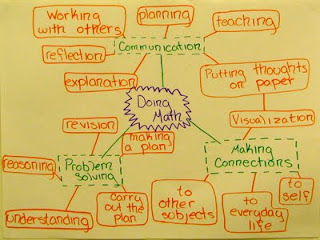There was a nice (if long-windedly titled) article in the Decemeber '03
Teaching Children Mathematics called "Metaphors as a Vehicle for Exploring Preservice Teachers' Perceptions of Mathematics," by Brenda Wolodoko, Katherine Wilson and Richard Johnson. In the article the preservice teachers made images to display themselves as teachers or learners of mathematics. The majority of their images revealed anxieties about the content as learners, but hope for themselves as teachers. The researchers liked the way that the images created an opportunity for dialogue and created a potential for change. One interesting sidenote is that students used the idea of puzzles both positively and negatively, modeling both frustration and engagement.
My preservice elementary teachers recently made images of what does it mean to teach mathematics in small groups, and our secondary student teachers envisioned their future classrooms. There were many neat ideas to share.
The mullet came later, but I think they thought the "Business in the front, party in the back," slogan did relate to teaching.

This and the next chart were imagined classrooms, which you'll see a lot of with the secondary teachers as well. They value group work, technology, manipulatives and whole class time. I often wish college classrooms had room for a carpet section for students to sit down.
These next two charts are more like concept maps. This group focused on the most important aspects to them.
While this group saw their concept map evolving into a hierarchy. There's some pretty interesting connections here to look into.
Somehow missed my favorite poster here. Clever use of Facebook, and really made me think about that page as a representation of who someone is. I think there are lots of idealized people I'd be interested in seeing Facebook pages for.
The secondary teacher assistants made quick individual sketches at the end of a seminar. So don't expect the artistic commitment we got from the elementary teachers. One thing that came across in classroom images is the presence of the kind of technology to which they've been exposed. It's becoming clear to me that we need to do a better job of teaching technological pedagogical content knowledge, primarily by explicit modeling.
Let's start off with a few of the text descriptions. This teacher is worried about the content they will be forced to cover.

This teacher is thinking about classroom management as the start of learning.
I'm not sure if this teacher was describing life as it is or as they envision. Somebody definitely considering the different models with which they've been presented.
Next come several visions of cooperative learning. There seems to be a clear value on student discussion, and varying images of what the teacher's role is in relation.


And this sketch merges a vision of the classroom with a concept map of what is important to them.
I'd be very interested in knowing what you think about the images here and what you notice, if you'd care to leave a comment or drop an email. Thanks!


 This is a solar system model - a little hard to see. They had fun developing the metaphor and the extending it. Used the idea of earth, other planets, the sun, constellations to all symbolize different roles.
This is a solar system model - a little hard to see. They had fun developing the metaphor and the extending it. Used the idea of earth, other planets, the sun, constellations to all symbolize different roles.




























